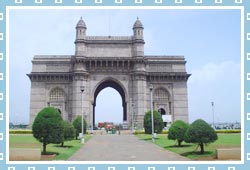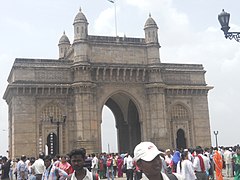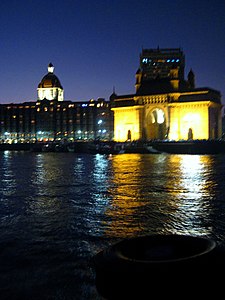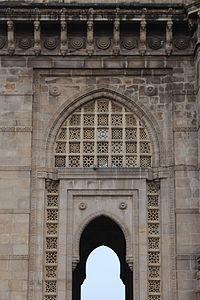4th DEC 1924 GATEWAY OF INDIA BUILT
INAUGRATED BY EARL OF READING
Gateway of India is India's most valued structure, which was built in 1924. Read this article to know more about the history, architecture and visiting hours of Gateway of India.
Gateway Of India
| Location: | Colaba, South Mumbai |
| Highlights/Famous For: | Indo-Saracenic style of architecture |
| Nearby Tourist Attractions: | Elephanta Caves and Taj Mahal Palace Hotel |
| How to Reach: | 2.5 km from Chhatrapati Shivaji Terminal and 2.4 km from Churchgate. |
 The Gateway of India is one of India's most unique landmarks situated in the city of Mumbai. The colossal structure was constructed in 1924. Located at the tip of Apollo Bunder, the gateway overlooks the Mumbai harbor, bordered by the Arabian Sea in the Colaba district. The Gateway of India is a monument that marks India's chief ports and is a major tourist attraction for visitors who arrive in India for the first time. At one point of time, this monument represented the grandeur of the British Raj in India. The total construction cost of this monument was approximately 21 lakhs and the whole expense was borne by the Indian government. A favourite spot for tourists, nowadays, this monument attracts vendors, food stalls and photographers. The passing of the 'First Battalion of the Somerset Light Infantry' was recorded as the first main event that took place at the Gateway of India. This ceremony was conducted on February 28, 1948, when the last set of British troops and divisions left India, post-independence.
The Gateway of India is one of India's most unique landmarks situated in the city of Mumbai. The colossal structure was constructed in 1924. Located at the tip of Apollo Bunder, the gateway overlooks the Mumbai harbor, bordered by the Arabian Sea in the Colaba district. The Gateway of India is a monument that marks India's chief ports and is a major tourist attraction for visitors who arrive in India for the first time. At one point of time, this monument represented the grandeur of the British Raj in India. The total construction cost of this monument was approximately 21 lakhs and the whole expense was borne by the Indian government. A favourite spot for tourists, nowadays, this monument attracts vendors, food stalls and photographers. The passing of the 'First Battalion of the Somerset Light Infantry' was recorded as the first main event that took place at the Gateway of India. This ceremony was conducted on February 28, 1948, when the last set of British troops and divisions left India, post-independence.History
The main objective behind the construction of the Gateway of India was to commemorate the visit of King George V and Queen Mary to Bombay (Mumbai). In March 1911, Sir George Sydenham Clarke, who was then the Governor of Bombay, laid down the monument's first foundation. Although, this plan was approved only in 1914, the reclamations at Apollo Bunder were completed only in 1919. The architectural design of Gateway of India was fashioned by architect, George Wittet. It took 4 years to complete this monument's construction.
Architectural Layout
The structural design of the Gateway of India is constituted of a large arch, with a height of 26m. The monument is built in yellow basalt and indissoluble concrete. The structural plan of Gateway of India is designed in the Indo-Saracenic style. One can also find traces of Muslim architectural styles incorporated in the structure of the grandiose edifice. The central dome of the monument is about 48 feet in diameter, with a total height of 83 feet. Designed with intricate latticework, the 4 turrets are the prominent features of the entire structure of the Gateway of India. There are steps constructed behind the arch of the Gateway that leads to the Arabian Sea. The monument is structured in such a way that one can witness the large expanse of the 'blue blanket' right ahead, welcoming and sending off ships and visitors.
Nearby Tourist Attractions
The Elephant Caves are located very close to the Gateway of India, and tourists can travel on motor boats to reach the Elephant Islands. Statues of the Maratha leader Shivaji and Swami Vivekananda are installed at the entrance of the Elephant Caves. The Taj Mahal Hotel is India's most prestigious and luxurious hotel and is situated close to the Gateway of India.
Visiting Hours
People can visit the monument at any time of the day. The best time to visit the Gateway of India is during the period of November to March, as the post-monsoon climate is very pleasant and there are very less chances for downpours at this time.
One of India's prized monuments, the Gateway of India was built in 1924. The Gateway of India is a major tourist hub in the city, which is located at Apollo Bunder Waterfront in Southern Mumbai. This monument was built to welcome King George V and Queen Mary to Mumbai and years later, the last horde of British troops left India through this gateway.
Gateway of India
From Wikipedia, the free encyclopedia
Not to be confused with India Gate.
| Gateway of India | |
|---|---|
| गेट वे आँफ इंडिया | |

The Gateway of India as seen from the harbour, 2003
| |
|
Location within Mumbai
| |
| Former names | Gilbert |
| General information | |
| Architectural style | Indo-Saracenic |
| Location | Mumbai, Maharashtra |
| Coordinates | 18.921836°N 72.834705°E |
| Elevation | 10 m (33 ft) |
| Construction started | 31 March 1911 |
| Completed | 1924 |
| Inaugurated | 4 December 1924 |
| Cost | ₹ 2.1 million (1911) |
| Client | India |
| Owner | Archaeological Survey of India |
| Height | 26 m (85 ft) |
| Dimensions | |
| Diameter | 15 metres (49 feet) |
| Design and construction | |
| Architect | George Wittet |
| Architecture firm | Gammon India[1] |
| Renovating team | |
| Architect | George Wittet |
The Gateway of India is a monument built during the British Rule in Mumbai City of Maharashtra state in Western India .[2] It is located on the waterfront in the Apollo Bunder area in South Mumbai and overlooks theArabian Sea.[3][4] The structure is a basalt arch, 26 metres (85 feet) high. It lies at the end of Chhatrapati Shivaji Marg at the water's edge in Mumbai Harbour.[5] It was a crude jetty used by the fishing community which was later renovated and used as a landing place for British governors and other prominent people. In earlier times, it would have been the first structure that visitors arriving by boat in Mumbai would have seen.[6][7] The Gateway has also been referred to as the Taj Mahal of Mumbai,[8] and is the city's top tourist attraction.[9] The India Gate in New Delhi is similar to the Gateway of India in Mumbai. The structure was erected to commemorate the landing of King George V and Queen Mary at Apollo Bunder, when they visited India in 1911. Built in Indo-Saracenic style, the foundation stone for the Gateway of India was laid on 31 March 1911. The final design of George Wittet was sanctioned in 1914 and the construction of the monument was completed in 1924. The Gateway was later the ceremonial entrance to India for Viceroys and the new Governors of Bombay.[10] It served to allow entry and access to India.[11]
The monument has witnessed three terror attacks from the beginning of the 21st century; twice in 2003 and it was also the disembarkation point in 2008 when four gunmen attacked the Taj Mahal Palace & Tower.
Contents
[hide]History[edit]
The Gateway of India was built to commemorate the visit of King George V and Queen Mary to Mumbai, prior to the Delhi Durbar, in December 1911. However, they only got to see a cardboard model of the structure since the construction did not begin till 1915.[12] The foundation stone was laid on 31 March 1911, by the governor of Bombay Sir George Sydenham Clarke, with the final design of George Wittet sanctioned on 31 March 1913. The gateway was built from yellow basalt and concrete.[13] Between 1915 and 1919, work proceeded at Apollo Bundar (Port) to reclaim the land on which the gateway and the new sea wall would be built. The foundations were completed in 1920, and construction was finished in 1924.[14] The gateway was opened on 4 December 1924, by the viceroy, the Earl of Reading.[6]
The last British troops to leave India following the country's independence, the First Battalion of the Somerset Light Infantry, passed through the gateway on their way out in a ceremony on 28 February 1948, signalling the end of British rule.[6][15]
Design and structure[edit]
The Scottish architect George Wittet combined the elements of the Roman triumphal arch and the 16th-century architecture of Gujarat.[16] Its design is a combination of Hinduand Muslim architectural styles; the arch is of Muslim style while the decorations are of Hindu style.[17] The gateway is built from yellow basalt and reinforced concrete.[12] The stone was locally obtained, and the perforated screens were brought from Gwalior.[18] The gateway faces out to Mumbai Harbour from the tip of Apollo Bunder.[19]
The central dome is 48 feet (15 metres) in diameter and 83 feet (25 metres) above the ground at its highest point.[20] The whole harbour front was realigned in order to come in line with a planned esplanade which would sweep down to the centre of the town. On each side of the arch, there are large halls that can hold 600 people.[12] The cost of the construction was ₹2 million (US$30,000), borne mainly by the Imperial Government of India. Due to a paucity of funds, the approach road was never built, and so the gateway stands at an angle to the road leading up to it.[6][20]
Significance[edit]
It is the place where the viceroys and governors used to land upon their arrival in India. Though built as a welcome to King George V for his visit of 1911, then an event of grand significance for British India and the British empire, today serves as a "monumental memento" of British colonial rule over India.[11] Built right next to the Taj Mahal Palace & Tower hotel,[21] for British arriving for the first time to India, the gateway was a symbol of the "power and majesty" of the British empire.[3]
Opposite the gateway stands the statue of Shivaji, the king who used guerilla warfare to establish the Maratha empire in the Sahyadri mountain range in the 17th century,[22] as a symbol of Maratha "pride and courage".[23] The statue was unveiled on 26 January 1961 on the occasion of India's Republic Day.[24][25] The other statue in the area is that of Swami Vivekananda.[26]
There are five jetties at the gateway.[27] The first jetty is exclusive to the Atomic Research Centre, the second and third are used for commercial ferry operations, the fourth is closed and the fifth is exclusive to the Royal Bombay Yacht Club.
After the 2008 Mumbai attacks, there has been a proposal to close all these jetties and replace them with two newer ones to be built near the Bombay Presidency Radio Club nearby.[28] The second and third jetties are the starting point for tours of Elephanta Caves, which is a 50-minute boat ride away by ferry.[21][29] Other routes from the Gateway include ferry rides to Alibaug and Mandwa; these ferries are said to carry passengers above their certified capacity due to their popularity.[30]
The Gateway of India is a major tourist destination and a popular gathering spot for locals, street vendors and photographers.[19] In 2012, Maharashtra Tourism Development Corporation moved the "Elephanta Festival of music and dance" from its original location at Elephanta Caves (where it had been celebrated for 23 years) to the Gateway due to the increased capacity offered by the venue. The Gateway can host 2,000 to 2,500 people, whereas Elephanta Caves could host only 700 to 800 people.[31][32]
A bomb planted in a taxi exploded near the gateway in the 2003.[9] The gateway was also the site of a major bomb-blast in August 2003 and was the disembarkation point of the terrorists participating in the November 2008 terror attacks when four gunmen attacked the Taj Mahal Palace & Tower.[33] Public movement in certain areas was restricted after the 2008 attacks.[34]
Gallery[edit]
See also[edit]
- List of tourist attractions in Mumbai
- India Gate
- Tourist attractions in Aurangabad, Maharashtra
- Make In Maharashtra
- Royal Bombay Yacht Club - the building directly opposite the Gateway to India
Search Results
Gateway of India -3D View - Flyover Bombay - YouTube
https://www.youtube.com/watch?v=_KigZ2swEwc
Jul 27, 2010 - Uploaded by renoldpereira
Explore the 3D bird view of Gateway of India & Taj Mahal Hotel,created in motion video editing by Renold ...GATEWAY OF INDIA MUMBAI INDIA - Amazing Light Show ...
https://www.youtube.com/watch?v=6hgprwgLAjc
Aug 27, 2014 - Uploaded by Imzy Allinone
The Gateway of India is a monument built during the British Raj in ... view of Gateway of India & Taj Mahal ...Mumbai: Gateway to India - YouTube
https://www.youtube.com/watch?v=IKoQwejtGVo
May 16, 2015 - Uploaded by The Salvation Army International Headquarters
At the Mumbai port of entry for early Salvationist pioneer Booth-Tucker who, with a small team established ...Gateway Of India - Amazing Historical place of India | Top ...
https://www.youtube.com/watch?v=PV4hAA3eNEw
Jul 6, 2015 - Uploaded by RkWorldTourism
Gate Way of India: The Gateway of India is a monument built during the ... the king who used guerilla warfare ...Amazing light show at Gateway of India 24th Jan 2014 ...
https://www.youtube.com/watch?v=qyad7cLMYus
Jan 24, 2014 - Uploaded by Imzy Allinone
Amazing light show at Gateway of India 24th Jan 2014 - Mumbai, India - Part 7 ... Amazing light effects created ...Amazing light show at Gateway of India 24th Jan 2014 ...
https://www.youtube.com/watch?v=cGmt1GzVNAM
Jan 24, 2014 - Uploaded by Imzy Allinone
Phillips lighting up Gateway of India Amazing light effectscreated at the Gateway and it looked wonderful at ...Flashmob at Gateway Of India Mumbai - YouTube
https://www.youtube.com/watch?v=48TDgD7Oihs
May 15, 2015 - Uploaded by RCKCtv
"The End Was Just The Beginning" This is a continuation of our debut Flashmob at Churchgate Station which ...Amazing light show at Gateway of India 24th Jan 2014 ...
https://www.youtube.com/watch?v=63OdGUkHreU
Jan 24, 2014 - Uploaded by Imzy Allinone
Phillips lighting up Gateway of India Amazing light effectscreated at the Gateway and it looked wonderful at ...Colorful Boats At Gateway Of India / Mumbai City Tour ...
https://www.youtube.com/watch?v=UtCWZbKVIY8
Jul 1, 2015 - Uploaded by tutun nath
Colorful Boats At Gateway Of India / Mumbai City Tour Maharashtra, India .colaba cha raja 2014 visarjan at gateway of india - YouTube
https://www.youtube.com/watch?v=G02FYkO5cVk
Dec 11, 2014 - Uploaded by Gandhar Khanvilkar
Colaba sarvajanik ganeshutasv mandal Established:-1951 24,ganeshgalli,
Stay up to date on results for gateway of india established.
Create alertSearch Results
Gateway of India - Wikipedia, the free encyclopedia
https://en.wikipedia.org/wiki/Gateway_of_India- People also ask
Gateway of India - Wikipedia, the free encyclopedia
https://en.wikipedia.org/wiki/Gateway_of_India
The foundation stone was laid on 31 March 1911, by the governor of Bombay Sir George Sydenham Clarke, with the final design of George Wittet sanctioned on 31 March 1913. The gateway was built from yellow basalt and concrete.
Location: Mumbai, Maharashtra
Architectural style: Indo-Saracenic
Construction started: 31 March 1911
Architecture firm: Gammon India
You visited this page on 3/12/15.
Gateway Of India Mumbai - History And Architecture
www.mumbai.org.uk/gate-way-of-india.html
Gateway of India is India's most valued structure, which was built in 1924. Read this article to know more about the history, architecture and visiting hours of ...
You visited this page on 3/12/15.
Gateway of India History
www.gatewayofindia.co.in/history/
May 16, 2013 - This is how the Gateway of India History goes. Gateway of India is the popular monumental building in the South Mumbai City area near Apollo ...HISTORY BEHIND GATEWAY OF INDIA - MUMBAI ...
historicaltimeofindia.blogspot.com/.../history-behind-gateway-of-india-...
Mar 9, 2013 - gate way of india is situated at the heart of city mumbai. You can check the great history behind the construction of gateway of india from history ...Gateway of India -3D View - Flyover Bombay - YouTube
https://www.youtube.com/watch?v=_KigZ2swEwc
Jul 27, 2010 - Uploaded by renoldpereira
Explore the 3D bird view of Gateway of India & Taj Mahal Hotel,created in motion video editing by Renold ...Gateway of India - Travel to India
www.bharatonline.com › ... › Mumbai › Mumbai Tourist Attractions
Read about Gateway of India, situated in Bombay/Mumbai. ... work of Gateway of India was undertaken by Gammon India Limited, established by J C Gammon.Which company built the Gateway of India? - Rediff.com
www.rediff.com › Business
The correct answer is Gammon (Bombay) Pvt Ltd. Gammon India Limited, which wasestablished by J C Gammon in 1919 as a civil engineering firm and called J C Gammon (Bombay) Pvt Ltd then, carried out the construction of reinforced concrete pile foundations for the Gateway of India.British Period - Gateway for India
www.gatewayforindia.com/history/british_history1.htm
In 1610, the British chased away a Portuguese naval squadron, and the East IndiaCompany created its own outpost at Surat. This small outpost marked the ...-Gateway of India established on which year...? - GK - SSC ...
gradestack.com/Gateway-of-India/28664-wqsq
Gateway of India established on which year...? Megaguru. Answer-1. Actualy 1912. Ajay Raj. Answer-2. 1912. Gyankumargupta. Answer-3. 131. Sagir Alam.Searches related to gateway of india established
Kharghar, Navi Mumbai, Maharashtra - From your Internet address - Use precise location





















No comments:
Post a Comment